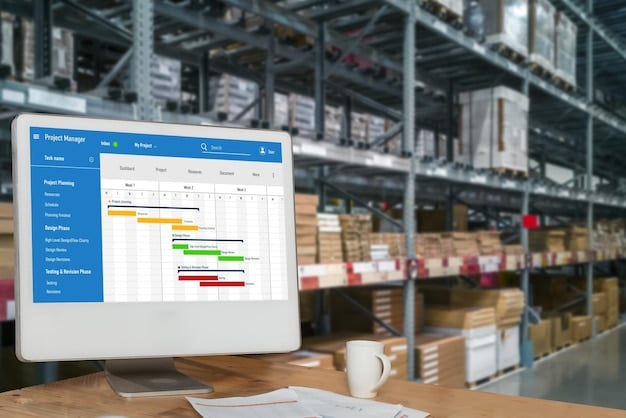E-commerce Shipping Rates to Surge: 2025 Profit Margin Impact

E-commerce shipping rates are projected to increase by 12% in 2025, significantly impacting profit margins for online retailers; businesses will need to optimize shipping strategies, negotiate with carriers, and explore alternative fulfillment options to mitigate the financial strain.
Get ready for a change! The projected e-commerce shipping rates surge of 12% in 2025 is set to reshape the profitability landscape for online businesses. Are you prepared to navigate these rising costs and protect your bottom line?
E-commerce Shipping Rates Set to Spike
The e-commerce sector is bracing for a significant shift as shipping rates are predicted to climb. This increase has the potential to squeeze profit margins across the board.
The Driving Forces Behind the Increase
Several factors are converging to push shipping rates higher. Understanding these forces is crucial for anticipating and adapting to the change.
- Rising Fuel Costs: Fluctuations in fuel prices directly impact shipping expenses.
- Increased Demand: The ever-growing volume of online orders puts a strain on shipping infrastructure.
- Labor Shortages: A shortage of drivers and warehouse staff is driving up labor costs.
Why This Matters to Your Bottom Line
Higher shipping rates translate to increased operational costs. This impacts pricing strategies and overall profitability.

Ignoring these cost increases could mean sacrificing your profit margins. It is therefore essential to proactively address the rising e-commerce shipping rates.
In conclusion, monitoring the factors influencing shipping rates and implementing proactive strategies can help your business navigate the upcoming cost increases.
Assessing the Impact on Your 2025 Profit Margins
To prepare for the 2025 surge in shipping rates, conducting comprehensive assessments of your current expenses is crucial. This will provide the knowledge and insights needed for better decisions.
Calculating Current Shipping Costs
Begin by carefully calculating your existing shipping expenses. A thorough calculation provides a baseline to measure the impact of the projected rate hike.
- Analyze Invoices: Review past shipping invoices to understand current spending levels.
- Factor in Hidden Costs: Consider expenses like packaging materials and returns processing.
- Project Volume: Estimate shipping volume for 2025 to accurately assess future costs.
Projecting the 12% Increase
With knowledge of current shipping costs, you can realistically project how the 12% rise will affect your profit margins.
Consider the impact on different product categories. Items with higher shipping costs will be affected the most.

Assess the combined impact on your total revenue. This exercise provides a complete picture of the potential financial strain.
In summary, proactively assessing the impact of the 12% rise on shipping rates allows for efficient resource allocation and realistic financial projections. Taking preemptive action can help offset potential losses.
Strategies to Mitigate Rising Shipping Costs
With the understanding that shipping costs will increase in 2025, developing strategies to reduce shipping costs is crucial for protecting your bottom line.
Negotiate with Carriers
One of the most effective ways to mitigate rising shipping costs is to take the time to explore every possible saving.
- Volume Discounts: Negotiate better rates or volume discounts if you ship large quantities.
- Shop Around: Explore rates from multiple carriers to find the most competitive options.
- Consolidate Shipments: Combine multiple orders into one shipment to reduce costs.
Optimize Packaging
Efficient packaging is another way to reduce your costs. Optimizing the size and weight of your packages can lead to significant savings.
Use lighter materials while ensuring the safety of the contents. Every ounce counts when it comes to shipping rates.
Switch to smaller boxes to reduce dimensional weight. This is especially important for oddly shaped items.
By taking measures to negotiate with carriers and optimize packaging, you can successfully offset the effect of rising e-commerce shipping rates.
Exploring Alternative Fulfillment Options
Considering alternative fulfillment methods is a proactive way to future-proof your company for 2025. This approach allows you to diversify your logistical strategies.
Third-Party Logistics (3PL)
Partnering with a 3PL provider can lead to substantial cost savings and increased efficiency.
3PL companies offer services such as warehousing, order fulfillment, and shipping. They leverage economies of scale to reduce expenses.
Outsourcing fulfillment allows you to focus on core operations like product development and marketing.
Dropshipping
Dropshipping eliminates the need to manage inventory or handle shipping directly.
In a dropshipping model, you forward orders to a third-party supplier who ships directly to the customer.
While dropshipping can reduce costs, ensure you partner with reliable suppliers to maintain service quality.
In-House Fulfillment
While it might seem counterintuitive, there may be strategic reasons to process fulfillment in-house to optimize the consumer experience.
If you own your own fulfillment, it may be easier to focus on things that cause other rates to go up, like returns. If you can create a better product and better customer experience, your return rates may lower, saving shipping costs.
Exploring alternate fulfillment options like 3PL, dropshipping and in-house fulfillment offers ways to adjust to the changing e-commerce shipping rates and ensure efficient operations.
Investing in Technology for Shipping Efficiency
Adopting technology to streamline your shipping operations is necessary in the face of future rate hikes. Automation may be a cost effective strategy.
Shipping Software
Shipping software centralizes and automates key processes, streamlining operations.
- Rate Shopping: Compare rates across carriers in real-time to secure the best possible deals.
- Automated Labeling: Automatically generate shipping labels, reducing manual errors and saving time.
- Inventory Management: Integrate inventory management to control stock levels to avoid delays and improve order fulfillment.
Warehouse Automation
Automating warehouse operations can drastically reduce labor costs and increase efficiency.
Invest in automated systems like conveyor belts and robotic arms. The initial investment can lead to long-term cost savings.
Optimize warehouse layout for faster order picking and packing. Reduce the time it takes to process each order.
Investing in shipping software and other automation technologies can enhance productivity and offset the impact of rising shipping rates.
Customer Communication and Transparency
Effectively communicating with customers about shipping costs is critical for maintaining trust and satisfaction. Communicating shipping policies can set expectations early in the consumer experience.
Clearly Display Shipping Costs
Transparency is key to preventing frustration and cart abandonment.
Clearly display shipping costs on the product page and during the checkout process. Make sure consumers are well aware of the shipping costs.
Avoid hidden fees or unexpected charges. Transparency builds trust with customers and reduces complaints.
Offer Flexible Shipping Options
Providing a range of shipping options allows customers to choose a service that meets their needs and budget.
Offer expedited shipping for urgent orders. Include slower modes for customers on a budget.
Consider offering free shipping for orders over a certain amount. This can incentivize larger purchases and increase sales.
Effectively communicating shipping charges and offering different shipping options can improve customer satisfaction while preparing consumers for high e-commerce shipping rates.
| Key Point | Brief Description |
|---|---|
| 📈 Rate Surge | E-commerce shipping rates will likely increase by 12% in 2025. |
| 💰 Profit Impact | Businesses must assess how this will impact profit margins. |
| 🚚 Carrier Negotiation | Negotiate rates, explore options and consolidate shipments. |
| 📦 Package Optimization | Switch to lighter materials, and minimize box sizes. |
Frequently Asked Questions
▼
Small businesses will see a higher proportion of their revenue going to shipping, potentially reducing competitiveness. They should focus on cost-saving strategies.
▼
Businesses can negotiate rates with carriers, optimize packaging to reduce weight and size, and fully explore regional shipping options. These can provide cost savings.
▼
Shipping software helps compare rates, automate label generation, and manage inventory. Technology can lead to more efficient processes and is generally more cost effective.
▼
Being upfront about shipping costs (displayed clearly), and providing flexible options improves transparency and can ease negative consumer sentiment or pushback.
▼
Businesses can invest in warehouse automation, partner with 3PL providers for efficiency, and focus on creating efficient customer experiences for less returns.
Conclusion
As e-commerce businesses face a projected 12% surge in shipping rates in 2025, the time to act is now. By thoroughly assessing the impact on your profit margins, implementing effective mitigation strategies, and ensuring clear customer communication, you can protect your bottom line and maintain a competitive edge. Stay informed, be proactive, and adapt to the changing landscape to thrive in the evolving world of e-commerce.





